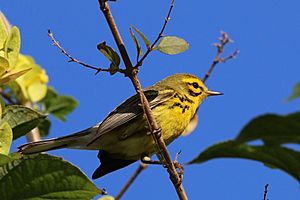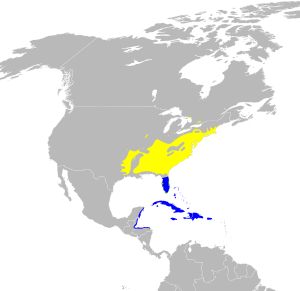Prairie warbler facts for kids
Quick facts for kids Prairie warbler |
|
|---|---|
 |
|
| Male S. d. paludicola Jamaica |
|
| Conservation status | |
| Scientific classification | |
| Genus: |
Setophaga
|
| Species: |
discolor
|
 |
|
| Range of S. discolor Breeding range Winter range | |
| Synonyms | |
|
|
The prairie warbler (Setophaga discolor) is a small, colorful songbird. It belongs to a group of birds called New World warblers, which are known for their beautiful songs.
Contents
About the Prairie Warbler
Prairie warblers are easy to spot! They have bright yellow feathers on their bellies. Their backs are olive green with some rusty stripes. Look closely at their faces: they have a yellow stripe above their eye, a dark line going through it, and another yellow spot just below. They also have black legs, long tails, and two light-colored stripes on their wings. Their beaks are thin and pointed, perfect for catching insects. Young birds and female warblers have colors that are a bit less bright.
How Big Are They?
| Standard Measurements | |
|---|---|
| Length | 4.3–5.2 in (110–130 mm) |
| Weight | 7.7 g (0.27 oz) |
| Wingspan | 7 in (180 mm) |
| Wing | 54.4–58.2 mm (2.14–2.29 in) |
| Tail | 47.5–50.5 mm (1.87–1.99 in) |
| Beak (Culmen) | 9–10.2 mm (0.35–0.40 in) |
| Leg (Tarsus) | 17–19 mm (0.67–0.75 in) |
Their Songs and Calls
Prairie warblers have two main types of songs, called Type A and Type B.
- Type A songs sound like a series of buzzy notes that go higher and higher.
- Type B songs are also a series of notes that go higher, but they sound more like whistles and often have some buzzy parts too. Type B songs are usually lower in sound and have fewer, longer notes than Type A songs. They also last longer.
Male warblers use these songs for different reasons. When they first arrive at their breeding grounds, they sing Type A songs all day. Once a male finds a mate, he starts singing Type B songs early in the morning. During the rest of the day, he mixes in Type A songs. Type A songs are often sung near females, close to the nest, and in the middle of their territory. Type B songs are used when they are interacting or fighting with other male warblers, especially near the edges of their territory.
They also make a "tsip" sound. In the morning, during their chorus of songs, they often add quick, loud "check" calls.
Where They Live
Some prairie warblers live in the southern parts of their range all year round. Other warblers migrate to warmer places like north-eastern Mexico and islands in the Caribbean during the colder months.
Life and Habits
Life Cycle and Reproduction
Prairie warblers build their nests in bushy areas and along the edges of forests in eastern North America. Their nests are shaped like open cups and are usually placed low down in a tree or shrub. The eggs hatch after about 12 to 13 days.
What They Eat
Prairie warblers are very active when they look for food. They search for insects on tree branches. Sometimes, they even fly around to catch insects in the air! Insects are their main food source.
Cool Habits
These birds often wag their tails back and forth. It's a fun behavior to watch!
Their Status
The number of prairie warblers is going down. This is mainly because they are losing their natural homes, or "habitat loss." They also face a challenge called nest parasitism. This happens when another bird, like the brown-headed cowbird, lays its eggs in the prairie warbler's nest. The cowbird chick then gets all the attention and food from the warbler parents, which can harm the warbler's own young.
Images for kids
See also
 In Spanish: Reinita galana para niños
In Spanish: Reinita galana para niños





